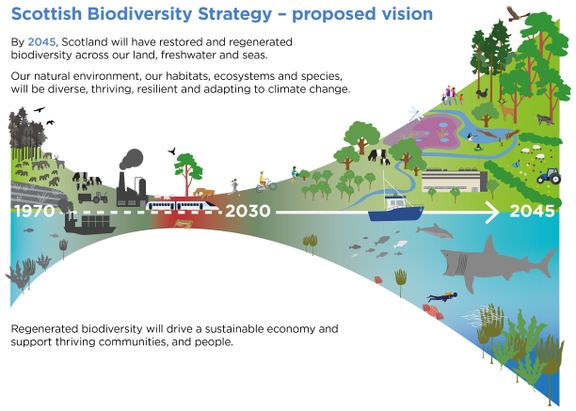
Nature Positive Places
Globally biodiversity is declining faster than at any time in human history, and Scotland is no exception. The Biodiversity Intactness Indicator suggests that Scotland has retained just over half of its historic land-based biodiversity. That is slightly more than other parts of the UK, but Scotland still ranks in the bottom 25% of nations.
The Scottish Biodiversity Strategy sets out a vision and actions to reverse the decline, and for Scotland to be Nature Positive by 2030. This means reversing the downward curve of biodiversity loss so that biodiversity levels are once again increasing, “bending the curve of biodiversity loss”. Our work on Nature Networks will be a key driver for that reversal in our Region.

National Planning Framework 4
NPF 4 emphasises the critical role Green Infrastructure (GI) and Nature-Based Solutions (NBS) have in delivering Nature Positive Places, particularly in urban areas. This is especially true in our region, home to one third of Scotland’s population, with constant pressure for new development. We must ensure that development designs in GI and NBS from the outset, maximising benefits for climate, nature and people.
Scotland’s future places will be net zero, nature-positive places that are designed to reduce emissions and adapts to the impacts of climate change, whilst protecting, recovering and restoring our environment.

Green Infrastructure
GI is green and blue space that has been planned, designed and managed to provide identified functions and benefits. In urban areas these include parks, wildlife habitat, green access corridors, street trees, sports pitches, green roofs and naturalised drainage systems.
NBS involves working with nature to address societal challenges, providing benefits for both human well-being and biodiversity based on actions that protect, restore or manage natural and semi-natural ecosystems

Planning for Green Infrastructure
The GCVGN has long championed GI in new development. In 2018 we launched our Planning for Green Infrastructure Brochure which set out a framework for assessing whether development proposals had fully considered GI and successfully integrated them into designs.
Although pre-dating NPF4 and LDP Guidance, it still provides a very useful aid to assessing whether new development has met the aspirations of those documents to delivery Nature Positive Places through new development

Nature Networks
Identifying, protecting and strengthening Nature Networks is a new requirement in NPF4 and for LDPs, but what is a Nature Network? In simple terms it means connecting our best nature rich areas via wildlife corridors and habitat stepping stones making a more permeable landscape for species to find food, mate and escape habitat loss. Nature Networks don’t stop at local authority boundaries and work best when considered strategically and at scale. We are working with the eight GCR authorities to develop a regionally consistent approach to Nature Networks that draws on existing data and new data developed by GCVGN, as well as local expertise.

A Nature Positive City Region
The urban nature of much of our region, combined with extensive agriculture, makes it more difficult for wildlife to move through the landscape. The region is also at a key “pinch point” between the Clyde and Forth Estuaries which some species will need to navigate as they move north due to climate change driven temperature increases.
Our Blueprint set out a strategic framework for delivery of regional Nature Networks, the ambitions of which are now being realised through our suite of delivery projects. These will collectively mean that Glasgow City Region makes a significant contribution to Scotland being nature positive by 2030.

Newsletter Signup
Learn more about GCV Green Network! You can be the first the hear about our latest news.



